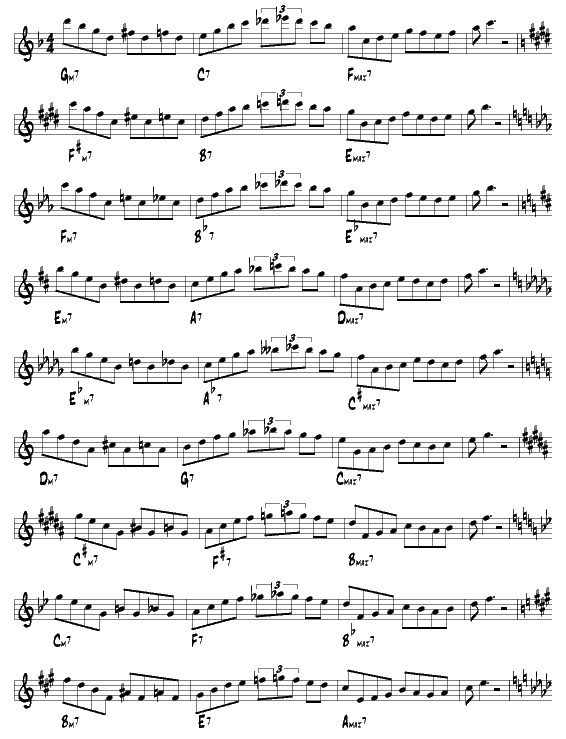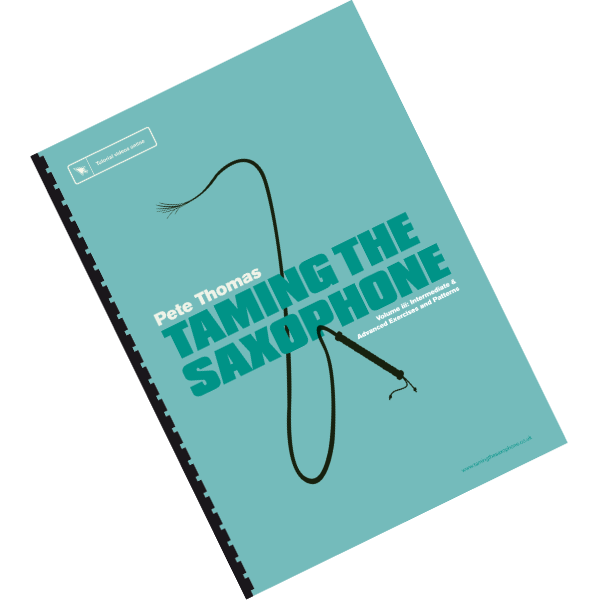IIm7-V7-I progressions (“2 5 1”)
“Why is the 2 5 1 so important in jazz (and blues)?”
I’ve already mentioned how the harmony of music can imply a feeling of movement away from or towards a state of rest. This is what can make the music interesting (or boring), depending on the way you do it. Sometimes this is heard simply as tension and release, but often it can be formalised by thinking about three main areas:
- Home
- Away
- Returning
If you have done some basic theory training you will know that traditionally these main areas are associated with chords:
- Tonic (home) is chord I
- Subdominant (away) is chord IV
- Dominant (returning home) is chord V7
These are the three main chords that make up a blues progression, in which case the I and IV often have a flattened seventh, but with a lot if jazz it’s more common to find a II, or IIm7 chord functioning as a subdominant.
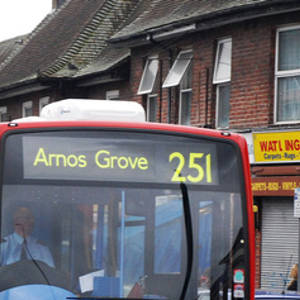 The V7 chord has a particularly strong pull back to the tonic chord due to the tritone interval between 3rd and 7th which has quite a lot of tension. Have a look on the jazz theory pages to find out more.
The V7 chord has a particularly strong pull back to the tonic chord due to the tritone interval between 3rd and 7th which has quite a lot of tension. Have a look on the jazz theory pages to find out more.
Voice Leading & Guide Tones on a IIm7-V7-I
The resolution from dominant to tonic is called a cadence and traditionally marks the end of a music phrase, like punctuation. There are different types of cadence, V7 – I is a called a perfect cadence. Apart from the obvious movement of the root notes downwards by a fifth, it is worth looking at how the other notes of a chord can move smoothly from one chord to another. In classical chorale harmony (and often jazz harmony) this can be done by arranging the notes of chords so each note moves by the smallest interval. This is called voice leading.
Along wityh voice leading it’s also good to consider that conventionally some notes have tendencies to move in a certain direction, and it can be very useful to exploit these tendencies when improvising solos, and these are often called guide tones. Even without the other notes of the chord they can often serve to define what the harmony is, or at least to imply very strongly what the chords are.
Here are three very important voice leading movements, they are not of course compulsory, surprises can be good, but you should be aware of them and experiment with using them.
| Chord | Note | Voice leading |
| Minor 7th | 7th | Down a semitone to 3rd of dominant |
| Dominant 7th | 3rd | Up a semitone to root of tonic |
| Dominant 7th | 7th | Down a semitone to 3rd of tonic |

We can look at this in a couple of different ways. First we’ll look at the chords played on a keyboard so you can see here how the voice leading works to make these chords progress smoothly from one to the next. In the first illustration the chords are shown as played in the right hand in root position, the whole chord moves up from Dm7 to G7, then down to C. In this case no attention has been paid to voice leading.

In this next example, the G7 chord is revoiced so the notes move smoothly from one to the next, you can see how the C resolves to the B then up to the C, and how the F resolves down to the E.
Very often keyboard players and guitarists will try to voice chords in this way so that there are smooth transitions from one note to the next.
The next two examples show how voice leading work with a simple arpeggio/scale patterns which outline the chords
 Here the C (7th of Dm7), falls nicely onto the B (3rd of G7) then up to the tonic C. (Note that although the C actually falls on the second half of beat four, anticipations in jazz usually take the harmony of the chord on the beat which they anticipate).
Here the C (7th of Dm7), falls nicely onto the B (3rd of G7) then up to the tonic C. (Note that although the C actually falls on the second half of beat four, anticipations in jazz usually take the harmony of the chord on the beat which they anticipate).
 In the next one the scale run down from B lands nicely on the 3rd of the C chord.
In the next one the scale run down from B lands nicely on the 3rd of the C chord.
The IIm7-V7-I chord progression is very common in jazz improvisation, many tunes consist entirely or almost entirely of IIm7-V7-Is, sometimes rapidly modulating through different keys (key centers) as in Giant Steps
It is totally up to the improviser when to choose to use voice leading like this. If you use it all the time then the lines will become very predictable, however it will often just happen unconsciously once your improvisation becomes fairly fluent, this is what the notes seem to “want” to do.
Juxtaposing the IIm7 and V7
Here is some good news…you don’t need to be totally precise about this. You can actually split this down into two areas rather than three and think of the IIm7-V7 almost as one chord. Certainly it sounds very neat when you get that voice leading of C to B on a Dm7 – G7, but it can work just as well to fit a IIm7 – V7 over just a V7.

Look again at the second keyboard example – the Dm7 chord is really no different to a G11, all it needs to make it a G11 is for there to be a G in the bass (G11 is often written as Dm7/G). “Ah, but a G11 is not a G7” I hear you say. The 9th is not an issue, it’s a note that can often be added to any 7th and adds just a very slight bit of color, but the 11th (or 4th) is supposed to be a clash against the 3rd. Well, so it is, but when it resolves down to the 3rd, it has just functioned as a suspension, which is absolutely fine – tension and release.
Sometimes a tune will have two whole bars of a dominant 7 chord, e.g. the bridge of I Got Rhythm. Pianists can play two bars of B7, or they might play one bar of F#m7 and one bar of B7 (i.e. making it a IIm7 – V7 instead of just a V7). Or they might play 2 beats each of F#m7, B7 repeated: |F#m7 / B7 /|F#m7 / B7 / |. You, as a soloist, may not know in advance what they are going to do, but usually it doesn’t matter, whatever you play will either be spot on or add some tension to this area. As long as you make a good resolution when it comes round to the tonic, all will be well, especially if what you play has some melodic interest – something that in jazz cuts far more than just playing the right notes (in my opinion).
Also see the jazz licks page
Ex 4.01
This a very basic IIm7 V7 I exercise which goes up a minor 7 arpeggio, then down an inverted V7 arpeggio to bring you nicely onto the root of the I major 7.
The image here shows the first page, Taming the Saxophone Vol 3 has the exercise written out in all keys (as well as all the other exercises and more)

Ex 4.02
This is similar to the previous exercise, except that instead of resolving to the root of a I major 7, it goes to the root of another IIm7 chord. This takes you round a cycle of fifths. Note that each IIm7-V7 pair is a whole tone lower than the previous one. The exercise is then repeated up a semitone so that the the notes that were the roots of the IIm7s are now the roots of the V7s, and vice versa.

Ex 4.03
Similarly, this pattern uses the cycle. The descending minor arpeggio ends on the 7th which then leads nicely (see above: voice leading) to the 3rd of the V7.

Ex 4.04
This is a useful lick used by John Coltrane. It starts with the basic ascending IIm7 arpeggio, then jumps from the 3rd to the 13th of the V7, which resolves nicely to the 9th of the I major 7 and a descending arpeggio.
The image here shows the first page, Taming the Saxophone Vol 3 has the exercise written out in all keys (as well as all the other exercises and more)
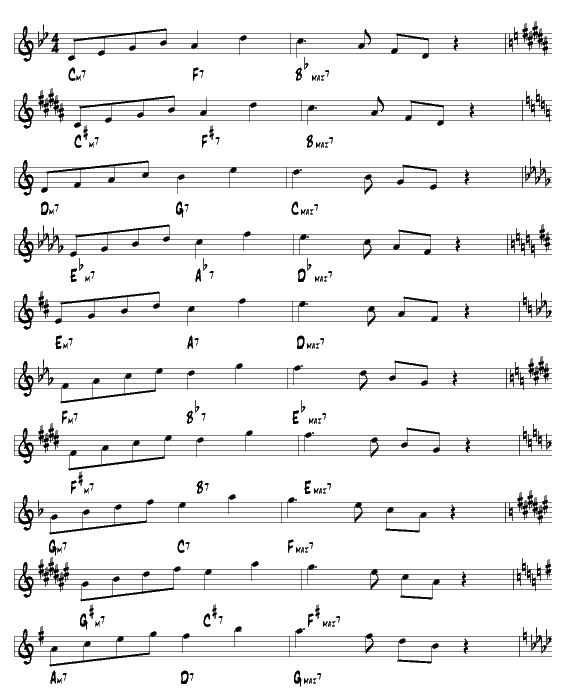
Ex 4.06
The opening bar of this lick really is a rather overused a cliché on the saxophone. (Is there such a thing as an under-used cliché?). However by transposing it down a semitone over the next chord you get some very nice chromatic notes giving you the b9, b13 and b5. To avoid double flats in places I have changed the enharmonic spelling in where it is ambiguous, e.g. on the Eb7 the B and A give you a #5th instead of b13th and #11th instead of b5th. I was taught this pattern by Bill Charlson, one of the truly great saxophone teachers.
The image here shows the first page, Taming the Saxophone Vol 3 has the exercise written out in all keys (as well as all the other exercises and more).
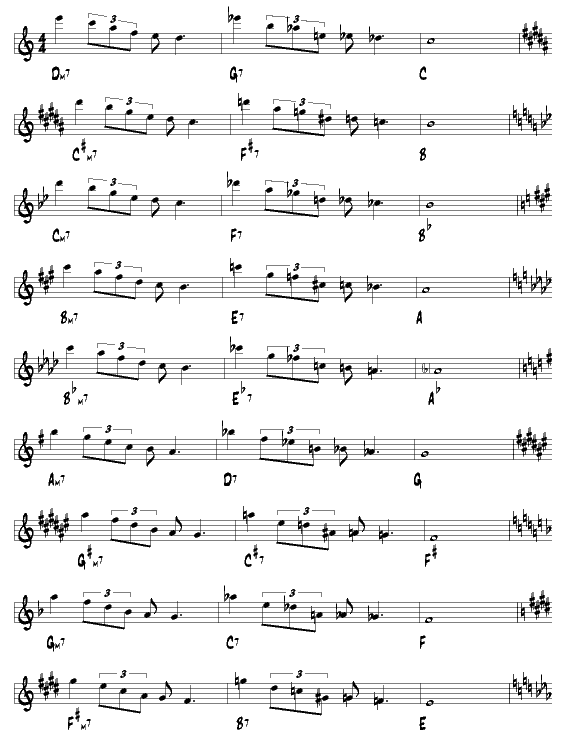
Ex 4.07
